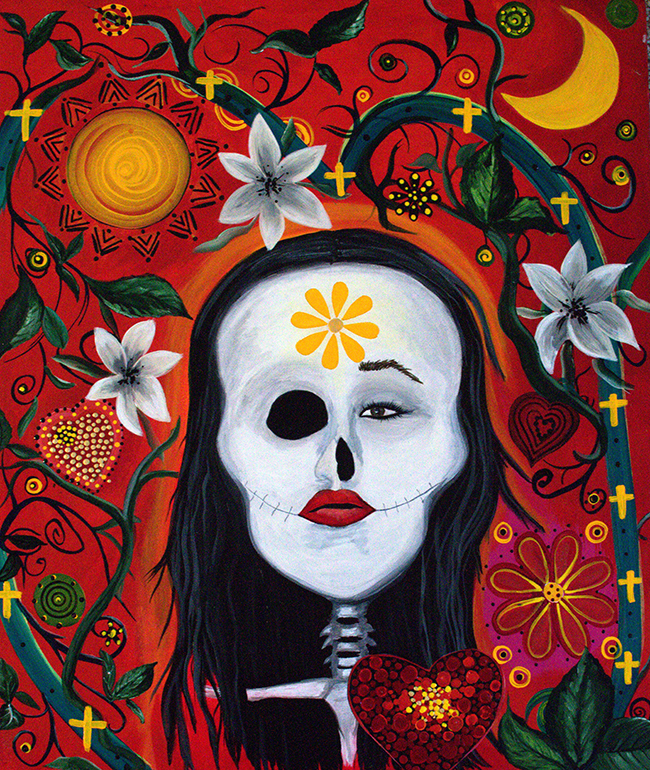The painting, crafted over a meticulous five-month span, serves as a self-portrait of Boswell during what she describes as the “dark night of the soul.” The canvas becomes a mirror reflecting her journey through the intricate layers of the human experience. At the core of this piece is the symbolism of Dias de los Muertos, the Latin celebration honoring departed souls. However, Boswell infuses her own twist, transcending the theme of death and emphasizing transformation.
The portrayal of herself as a figure in Dias de los Muertos costume is a nod to the celebration’s essence—a vibrant and joyous commemoration of life. In Boswell’s interpretation, death is not the finality but a profound metamorphosis. The artwork urges viewers to perceive life as a continuous cycle, where the Wheel of Destiny ceaselessly turns, indifferent to the constraints of time.
The artist delves into the concept that our destinies are inevitable and inescapable, akin to the caterpillar’s transformation into a butterfly. This metamorphic process, symbolized by the shift from legs to wings, encapsulates the essence of overcoming fears and embracing freedom. For Boswell, life is a journey not confined by the limitations of the mind but defined by the boundless expanses of the heart.
Boswell’s rich cultural heritage plays a pivotal role in shaping her artistic expression. Her mother’s Latin and Native American roots, stemming from Tampico, Mexico, and the Mescalero tribe of the Apache Nation, infuse her work with a profound connection to ancient traditions. The juxtaposition of these influences with her father’s German and Austrian descent adds another layer of complexity to Boswell’s artistic identity.
The fusion of Latin and Native American elements with European ancestry creates a visual tapestry that resonates with a global audience. It is a testament to the artist’s ability to bridge cultural divides, inviting viewers to explore the intersections of diverse traditions within a single canvas.
Boswell’s message extends beyond the visual aesthetics of her art; it is embedded in the philosophy of love as an alchemizing power. The concept of love, as depicted in “Love Ever After,” transcends opposites, holding everything together in a harmonious union. This alchemy, according to Boswell, allows love to persist regardless of our cosmic location, emphasizing its enduring nature.
In a spartan and conversational tone, Boswell concludes with the powerful sentiment of “Namaste.” This ancient Sanskrit greeting encapsulates the essence of recognizing the divine within oneself and others. It serves as a poignant conclusion to the artist’s reflections, echoing a universal connection that transcends cultural, geographical, and temporal boundaries.
Karen Boswell’s “Love Ever After” not only invites viewers to witness the intricate dance of life and death but also challenges them to reflect on their own transformative journeys. Through a convergence of cultural influences and a celebration of love as a unifying force, Boswell emerges as an artist who not only captures the complexities of existence but also offers a guiding light towards a profound understanding of self and the world.


